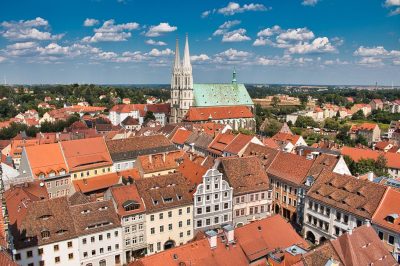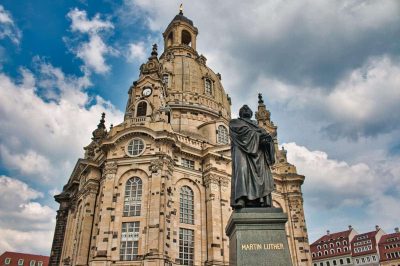Zittau Germany is often overlooked, although there are many Zittau sights. The city is scenically located at the foot of the Zittau Mountains, yet not very many tourists come here. But we think you should put Zittau on your to-do list for your next trip. Because Zittau is one of the most beautiful sights in Saxony and there is a lot to see! Some of the sights in Zittau are even unique.

Market Square and Town Hall
The market square is the central square of the city. It reflects the eras in which Zittau grew into an elegant city with many trade connections. Many of the houses also show the former wealth of Zittau’s citizens. On the west side of the market, at the corner with Mandauer Berg, stands a particularly beautiful house. In front of it, the striking Mars Fountain provides cooling. But the biggest eye-catcher is the town hall, built between 1840 and 1845. City architect Carl August Schramm built it according to plans by Karl Friedrich Schinkel.

St. John’s Church with tower
St. John’s Church is squeezed between the buildings of the old town, but this makes it seem all the larger. Today’s St. John’s Church was completed in 1833 by Karl Friedrich Schinkel, Berlin’s most important architect, after the new building had many defects. The church is kept simple in Protestant style. However, the installation of lamps in the rows of pews is interesting, because Schinkel is said to have been of the opinion that light should be close to the people.
You can climb the south tower of the church. There are 266 steps to the best view of Zittau Germany. From here you have a fantastic view of the market square and the whole of Zittau. The church’s turret flat is even still inhabited, although it’s not clear how long it will stay that way. Johannes the cat also lives here, his litter box is about 150 steps below.

Zittau Lenten Cloths
The Zittau Lenten Cloths (“Fastentücher” in German) are important artifacts of the Middle Ages. The largest lenten cloth in the world can be seen in the Church of the Holy Cross (Heiligkreuzkirche). Scenes from the Bible are depicted in 90 pictures. And this diligence of the creators, whose names are still unknown, was rewarded, because the large lenten cloth not only survived devastating fires in the city.
It also survived the Second World War, hidden in a bomb-proof cellar until Soviet soldiers used it as a tent tarp. After their withdrawal, the cloth was found in the forest by a villager and brought back to Zittau Germany, where it also survived the GDR. It was not until 1995 that the work was restored by experts, and since the end of the 1990s it has been on display again in Zittau. The small Lenten cloth in the former Franciscan monastery is also a genuine work of art. Admission costs 5 euros per museum or 8 euros for both with a combined ticket.

Salt House
In the 14th century, salt was one of the most important trade goods. Even if no salt was extracted in Zittau itself, towns could obtain a so-called stacking right for salt. This meant that traders passing through had to offer the salt for sale here and for this reason the salt house was built there. Later, it was extended as a warehouse and more storeys were added. Since 2002, it has housed a cultural centre with a library, restaurants, shops and offices.
The Zittau Legend Trail connects all important legends from a book about legends in Saxony on 14 stations. At the stations you can read the legends and learn more about the respective places. The tour is very entertaining due to the varied legends and also interesting for children. All legends and stations can be found on a page of the Zittau Tourism Association. Here you can also learn more about the founding legend of Zittau.

Zittau Pop Art District Mandauer Glanz
For those familiar with the dreariness of East German prefabricated buildings, the artists’ quarter of Zittau Mandauer Glanz must seem like a revelation. It is a prefabricated housing estate that appears bright and friendly and is a total work of art, a concrete quarter that people move to instead of leaving. In the beginning, the artists’ quarter of Zittau was viewed critically by many. In the meantime, the people of Zittau have not only accepted it, it is even very popular.
Designed by a Berlin architectural office and created by artist Sergej Alexander Dott, six prefabricated buildings were to be renovated. Not only were the prefabricated buildings painted brightly, but artworks were also attached to the houses and sculptures were erected. The landmark is an arch between two buildings that represents the DNA double helix shape. We think that more prefabricated buildings could be transformed into art objects of this kind.

Municipal Bath
The Municipal Bath (Stadtbad) is the oldest indoor swimming pool in Germany that is still in operation. Opened in 1874, it was incidentally one of the first baths with a steam bath and a wave system. At the time, this was all the rage. After it continued to fall into disrepair during GDR times and after the fall of communism, the German Foundation for the Protection of Historical Monuments stepped in and the baths were extensively renovated in the years that followed. Since 2008, visitors have once again been able to splash around in the historic ambience.

Robur Factory Zittau
The state-owned Robur Factory Zittau was a lesser-known factory in the GDR – even though widely used vehicles were built here. Robur produced trucks and buses that, with their characteristic design, were used by the National People’ s Army (NVA) and fire brigades, among others. After reunification, most parts of the factory were closed.
Today, a company still operates under this name. However, entire vehicles are no longer manufactured there. On the way from the station to the old town, you will pass Bahnhofstraße 25a. Two restored Robur buses are parked here. If you come with several people, you can even rent the Robur buses. If not, you can at least take some nice photos with these restored gems.

Zittau narrow gauge railway
The narrow-gauge railway line from Zittau to Oybin and Jonsdorf was opened as early as 1890. And to this day, the line connects Zittau with the spa town of Jonsdorf and Oybin with its beautiful monastery. The trips take place up to eight times a day. In summer, additional trips with diesel locomotives are added to the steam locomotive trips. Tickets are comparatively cheap. If you only want to have a little steam locomotive feeling once, you can ride individual stations for less than four euros. But a trip to Oybin and Jonsdorf is definitely a nicer experience.
Zittau sights outside the centre
Border triangle Germany, Poland, Czech Republic
Zittau is not only very far in the east of Germany. Three countries also meet near the city. From Zittau it is less than ten kilometres to the Czech Republic and Poland. And all three countries meet just outside Zittau on a meadow on the Lusatian Neisse. Flags of the three countries stand at the border triangle, making the place, which is inconspicuous due to the open borders, visible. A monument commemorates the day the borders were opened by the EU’s eastward expansion on 1 May 2004. Theoretically, by the way, Germany lies on the other side of the Neisse. Nevertheless, Germany is also included at the border triangle, but the correct point is in the middle of the river.
Neisse Viaduct
One of the oldest railway bridges in Germany is also located in Zittau and crosses the Neisse River. Since 1859, the bridge has connected Zittau with Liberec (then still Reichenberg). It used to be a bridge in the city. But since 1945, part of Zittau has been on the Polish side and now forms the Polish municipality of Porajów. The bridge consists of 39 arches and stretches over a length of 745 metres. The height of 18 metres is not spectacular, but with a train passing over it, it still makes a nice photo motif.
Restaurants in Zittau
- Dornspachhaus – Delicious regional cuisine prepared with skill. The best restaurant in Zittau to sample Upper Lusatian, Silesian and Bohemian cuisine. Seen in this light, the Dornspachhaus forms the culinary border triangle.
- Zum Alten Sack – Likewise well-prepared home cooking is available in an old warehouse in the centre. Here you can discover Lusatian cuisine and get to know the local dialect.
- Scholek – The Scholek serves upscale cuisine prepared with a lot of finesse.
- Café Weber – The largest selection of cakes and tarts in Zittau makes this café a must for those with a sweet tooth.
No products found.
No products found.
No products found.
No products found.



